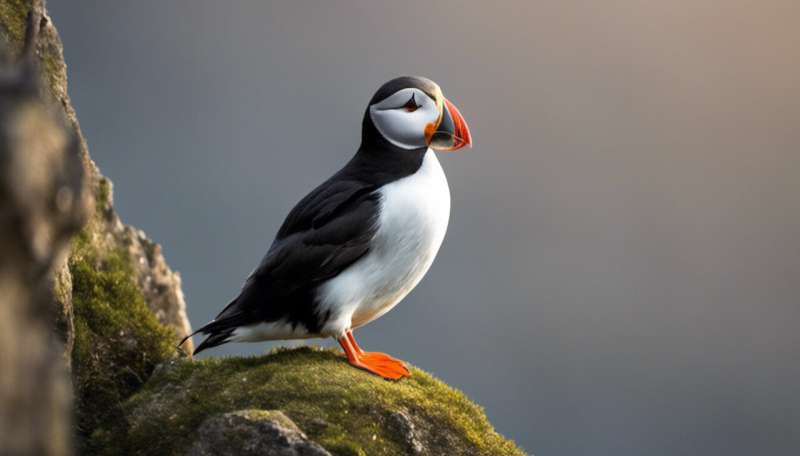The threats behind the plight of the puffin

Puffins are facing a perilous future. Population numbers have fallen sharply, and there are even fears the sea bird could be heading towards extinction within the next 100 years.
A much loved and enigmatic creature, puffins are easily identified by their wonderfully coloured beaks. They waddle around in a characterful fashion and make the strangest of noises. Their endearing features have been used as the symbol of children's books, and to illustrate many stamps – but they are now also appearing on lists of endangered species.
On Britain's Farne Islands, numbers have gone down 12% on average over just five years, with one island's population falling by 42%.
The common puffin, named after its puffed-up swollen appearance (although its scientific name, Fratercula arctica, arises from its resemblance to a friar wearing robes) has an extensive range across the northern hemisphere, with breeding colonies from Norway to Newfoundland.
Around 90% of the global population is found in Europe, with 60% of the population breeding in Iceland (which is also home to a tradition which involves children rescuing young, wayward puffins – "pufflings" – and returning them to the safety of the sea). The UK is home to 10% of the global puffin population, breeding on many islands and mainland coastal areas.
Although there are around 450,000 puffins in the UK, the species is threatened with extinction due to their rapid and ongoing population decline. Recent surveys of the Farne Islands revealed that despite a steady increase over the previous 70 years, numbers have declined by as much as 42% over the past five years.
Unfortunately, we know very little about the ecology of the puffin outside the breeding season. Although the birds amass in large numbers to breed, they spend two-thirds of their life alone, out in the north Atlantic sea. Consequently, they are very difficult to monitor.
What's causing the decline?
Firstly, although puffins live for a fairly long time (the oldest recorded so far reached the age of 34), their breeding population is limited to a small number of sites. They also have a low reproductive rate, laying just one egg a year, which makes them particularly vulnerable to adverse changes in the environment and means they can take a long while to recover from negative impacts.
They are also hunted – by humans and other animals. Smoked or dried puffin is considered a delicacy (or a flavouring for porridge) in some places, such as Iceland and the Faroe Islands. But although they were once over harvested by people, hunting is now maintained at a sustainable level.
During the breeding season, puffins nest in burrows on clifftops. Although this offers the nest protection from aerial predators, such as gulls, chicks and eggs are not safe from mammals, including weasels and foxes. On Lundy Island in the Bristol Channel, the population of puffins fell to just 10 pairs, but since the eradication of rats there, things are looking up. Nevertheless, the Arctic skua can be a particular problem as it steals food from adult puffins which is intended for their young.
Living on the open ocean makes the puffin highly susceptible to pollution such as oil spills. After the Torrey Canyon oil spill in 1967, the number of puffins breeding in France the following year decreased by a massive 85%.
The puffin feeds almost entirely on small fish, including sandeels, herring and capelin, which make up over 90% of the diet of pufflings.
The birds have a specialised beak with backwards facing spines, which prevents their prey (up to around 60 fish at a time) from falling out of their mouths when foraging. But in years where the main food source is low, many chicks starve to death.
Puffins have also suffered increased mortality from the rising frequency and intensity of extreme weather events associated with climate change. A recent succession of severe storms caused 54,000 seabirds, half of which were puffins, to be washed up along coasts. Starvation was cited as the main cause of death.
On a cliff edge
Sea temperatures have increased over the past 30 years, causing indirect effects on puffin survival. The rise in temperature decreases the abundance of plankton, which in turn leads to a reduction in the growth and survival of young sandeel and herring on which the puffins rely, particularly during the breeding season. Conditions in the North Sea are even causing some puffins to travel into the Atlantic, rather than the North Sea, in search of food – a perilous trek involving greater distances and different habitats.
It seems that a combination of factors are to blame for the decline in puffins, but the reduction in their food supply, particularly as a result of increased sea temperatures, appears to be the main culprit.
We need to continue monitoring puffins worldwide to better understand factors affecting populations. Hopefully, we can put measures in place to minimise pollution, reduce introduced predators and promote sustainable harvesting to try and ensure that the fate of this wonderful bird is not the same as that of the dodo.
Provided by The Conversation
This article was originally published on The Conversation. Read the original article.![]()

















